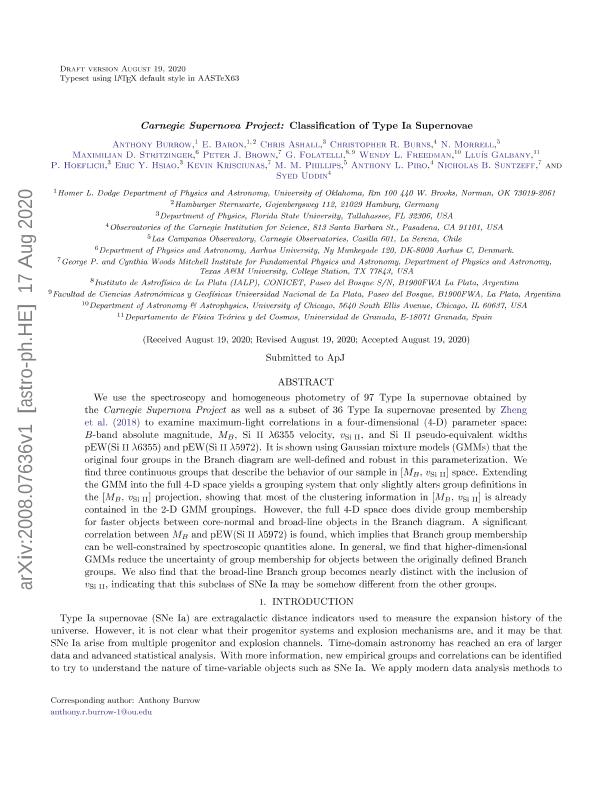Mostrar el registro sencillo del ítem
dc.contributor.author
Anthony, Lilian María

dc.contributor.author
Baron, Edward

dc.contributor.author
Ashall, Chris

dc.contributor.author
Burns, Christopher R.

dc.contributor.author
Morrell, Nidia Irene

dc.contributor.author
Stritzinger, Maximilian

dc.contributor.author
Brown, Peter J.
dc.contributor.author
Folatelli, Gaston

dc.contributor.author
Freedman, Wendy L.
dc.contributor.author
Galbany, Lluís

dc.contributor.author
Hoeflich, Peter

dc.contributor.author
Hsiao, Eric

dc.contributor.author
Krisciunas, Kevin

dc.contributor.author
Phillips, M. M.
dc.contributor.author
Piro, Anthony L.
dc.contributor.author
Suntzeff, Nicholas B.

dc.contributor.author
Uddin, Syed
dc.date.available
2021-11-26T16:33:30Z
dc.date.issued
2020-10
dc.identifier.citation
Anthony, Lilian María; Baron, Edward; Ashall, Chris; Burns, Christopher R.; Morrell, Nidia Irene; et al.; Carnegie supernova project: classification of type Ia supernovae; IOP Publishing; Astrophysical Journal; 901; 2; 10-2020; 154-179
dc.identifier.issn
0004-637X
dc.identifier.uri
http://hdl.handle.net/11336/147528
dc.description.abstract
We use the spectroscopy and homogeneous photometry of 97 Type Ia supernovae (SNe Ia) obtained by the Carnegie Supernova Project as well as a subset of 36 SNe Ia presented by Zheng et al. to examine maximum-light correlations in a four-dimensional (4D) parameter space: B-band absolute magnitude, MB, Si II λ6355 velocity, vSi II, and Si II pseudo-equivalent widths pEW(Si II λ6355) and pEW(Si II λ5972). It is shown using Gaussian mixture models (GMMs) that the original four groups in the Branch diagram are well-defined and robust in this parameterization. We find three continuous groups that describe the behavior of our sample in [MB, vSi II] space. Extending the GMM into the full 4D space yields a grouping system that only slightly alters group definitions in the [MB, vSi II] projection, showing that most of the clustering information in [MB, vSi II] is already contained in the 2D GMM groupings. However, the full 4D space does divide group membership for faster objects between core-normal and broad-line objects in the Branch diagram. A significant correlation between MB and pseudo-equivalent width (Si II λ5972) is found, which implies that Branch group membership can be well-constrained by spectroscopic quantities alone. In general, we find that higher-dimensional GMMs reduce the uncertainty of group membership for objects between the originally defined Branch groups. We also find that the broad-line Branch group becomes nearly distinct with the inclusion of vSi II, indicating that this subclass of SNe Ia may be somehow different from the other groups.
dc.format
application/pdf
dc.language.iso
eng
dc.publisher
IOP Publishing

dc.rights
info:eu-repo/semantics/openAccess
dc.rights.uri
https://creativecommons.org/licenses/by-nc-sa/2.5/ar/
dc.subject
Supernovae
dc.subject
Carnegie Supernova Project
dc.subject.classification
Astronomía

dc.subject.classification
Ciencias Físicas

dc.subject.classification
CIENCIAS NATURALES Y EXACTAS

dc.title
Carnegie supernova project: classification of type Ia supernovae
dc.type
info:eu-repo/semantics/article
dc.type
info:ar-repo/semantics/artículo
dc.type
info:eu-repo/semantics/publishedVersion
dc.date.updated
2021-07-01T14:51:29Z
dc.journal.volume
901
dc.journal.number
2
dc.journal.pagination
154-179
dc.journal.pais
Estados Unidos

dc.description.fil
Fil: Anthony, Lilian María. Oklahoma State University; Estados Unidos
dc.description.fil
Fil: Baron, Edward. Oklahoma State University; Estados Unidos. Universitat Hamburg; Alemania
dc.description.fil
Fil: Ashall, Chris. Florida State University; Estados Unidos
dc.description.fil
Fil: Burns, Christopher R.. Carnegie Observatories; Estados Unidos
dc.description.fil
Fil: Morrell, Nidia Irene. Las Campanas Observatory; Chile
dc.description.fil
Fil: Stritzinger, Maximilian. University Aarhus; Dinamarca
dc.description.fil
Fil: Brown, Peter J.. Texas A&M University; Estados Unidos
dc.description.fil
Fil: Folatelli, Gaston. Consejo Nacional de Investigaciones Científicas y Técnicas. Centro Científico Tecnológico Conicet - La Plata. Instituto de Astrofísica La Plata. Universidad Nacional de La Plata. Facultad de Ciencias Astronómicas y Geofísicas. Instituto de Astrofísica La Plata; Argentina
dc.description.fil
Fil: Freedman, Wendy L.. University of Chicago; Estados Unidos
dc.description.fil
Fil: Galbany, Lluís. Universidad de Granada; España
dc.description.fil
Fil: Hoeflich, Peter. Florida State University; Estados Unidos
dc.description.fil
Fil: Hsiao, Eric. Florida State University; Estados Unidos
dc.description.fil
Fil: Krisciunas, Kevin. Texas A&M University; Estados Unidos
dc.description.fil
Fil: Phillips, M. M.. Las Campanas Observatory; Chile
dc.description.fil
Fil: Piro, Anthony L.. Carnegie Observatories; Estados Unidos
dc.description.fil
Fil: Suntzeff, Nicholas B.. Texas A&M University; Estados Unidos
dc.description.fil
Fil: Uddin, Syed. Carnegie Observatories; Estados Unidos
dc.journal.title
Astrophysical Journal

dc.relation.alternativeid
info:eu-repo/semantics/altIdentifier/doi/http://dx.doi.org/10.3847/1538-4357/abafa2
dc.relation.alternativeid
info:eu-repo/semantics/altIdentifier/url/https://iopscience.iop.org/article/10.3847/1538-4357/abafa2
Archivos asociados
